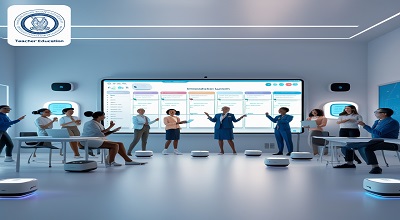Voice-assisted PD (Alexa/Google)
Voice-assisted PD (Alexa/Google): The integration of voice-assisted technology into professional development (PD) for educators is revolutionizing how teachers learn, plan, and engage with educational content. With smart assistants like Alexa and Google Assistant, educators can now access hands-free training, reminders, and resources, making PD more efficient and accessible.
In this comprehensive guide, we’ll explore the latest advancements in voice-assisted PD, how teachers can leverage these tools, and what the future holds for AI-driven professional learning.
What is Voice-assisted PD?
Voice-assisted professional development (PD) refers to the use of AI-powered voice assistants like Amazon Alexa and Google Assistant to deliver training, reminders, and educational resources to teachers.
Key Benefits:
✅ Hands-free learning – Access PD content without typing.
✅ Personalized training – AI tailors recommendations based on teacher needs.
✅ Time-efficient – Quick access to lesson plans, research, and best practices.
✅ Accessibility – Supports educators with disabilities.
How Alexa & Google Assistant Enhance Teacher PD?
Voice assistants help educators in multiple ways:
A. On-Demand Learning
Teachers can ask:
- “Alexa, what are the latest teaching strategies for STEM?”
- “Google, give me a PD webinar on classroom management.”
B. Daily Reminders & Scheduling
- Set reminders for PD sessions, meetings, or deadlines.
- “Alexa, remind me to complete my PD module at 4 PM.”
C. Interactive Skill-Based Learning
- Alexa Skills for Teachers (e.g., “Education Week,” “Edutopia”)
- Google Assistant Actions (e.g., “Khan Academy,” “TED-Ed”)
D. Language & Accessibility Support
- Multilingual PD content for ESL teachers.
- Voice commands for visually impaired educators.
Latest Features & Updates in Voice-assisted PD
A. AI-Powered Coaching (2025 Updates)
- Google’s Duplex AI can now simulate mock parent-teacher conversations for PD.
- Alexa’s Education Skill API allows schools to create custom PD modules.
B. Integration with LMS (Learning Management Systems)
- Voice assistants now sync with Canvas, Moodle, and Google Classroom.
- “Alexa, what’s due in my PD course this week?”
C. Real-Time Feedback & Analytics
- Teachers get instant feedback on their PD progress.
- “Google, how many PD hours have I completed this month?”
Case Studies: Schools Using Voice Tech for PD
1: Miami-Dade Public Schools
- Implemented Alexa for Teachers to deliver bite-sized PD.
- Result: 30% increase in PD completion rates.
2: Singapore’s Smart Teacher Program
- Uses Google Assistant for multilingual PD.
- Result: Improved engagement among non-native English-speaking teachers.
Challenges & Limitations
❌ Privacy Concerns – Data security with voice recordings.
❌ Limited Customization – Not all PD needs are voice-friendly.
❌ Internet Dependency – Requires stable connectivity.
Future of Voice-assisted PD
Predictions for 2025:
- Hyper-personalized AI coaches for teachers.
- VR + Voice integration for immersive PD.
- More school-wide voice assistant adoption.
How to Get Started with Voice-assisted PD?
1: Choose Your Device
- Amazon Echo (Alexa) / Google Nest (Assistant)
2: Enable Education Skills
- “Alexa, enable ‘Teacher PD Companion.’”
3: Set Up Daily PD Routines
- “Hey Google, start my morning PD briefing.”
4: Track Progress
- Use voice analytics to monitor PD hours.
More Read: Explainable AI (XAI)
FAQs
Q1: Is voice-assisted PD secure?
A: Yes, but ensure your school’s data policies comply with GDPR/COPPA.
Q2: Can voice assistants replace traditional PD?
A: No, but they enhance accessibility and efficiency.
Q3: Which is better—Alexa or Google Assistant for PD?
A: Google Assistant excels in research-based queries, while Alexa has more third-party education skills.
Conclusion
Voice-assisted PD is transforming teacher education by making learning more accessible, interactive, and efficient. With Alexa and Google Assistant leading the way, educators can now engage in PD seamlessly—whether at home or in the classroom.
More Here: Pi Network App
